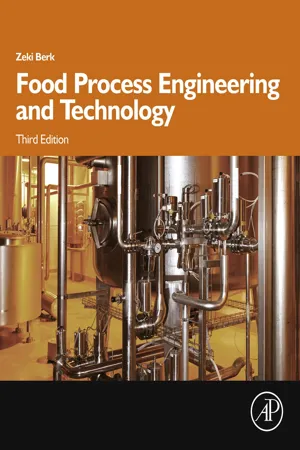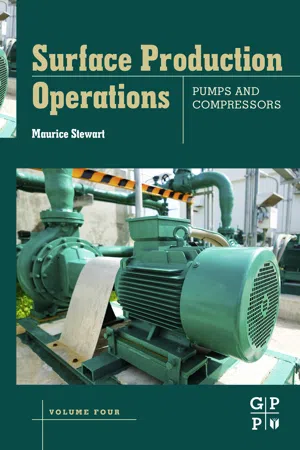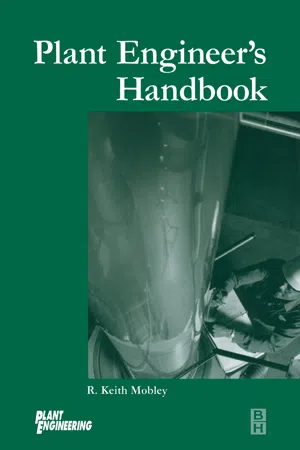Technology & Engineering
Fluid Pumps
Fluid pumps are devices used to move liquids or gases by increasing the fluid's pressure. They are commonly used in various applications, including industrial, commercial, and residential settings. Fluid pumps come in different types, such as centrifugal pumps, positive displacement pumps, and axial flow pumps, each designed for specific fluid-handling needs.
Written by Perlego with AI-assistance
Related key terms
Related key terms
1 of 4
Related key terms
1 of 3
5 Key excerpts on "Fluid Pumps"
- Amithirigala Widhanelage Jayawardena(Author)
- 2021(Publication Date)
- CRC Press(Publisher)
Chapter 12 Fluid machinery12.1 Introduction
Fluid machinery can be broadly classified into two types; namely, pumps and turbines. Pumps convert mechanical energy into fluid energy, thereby increasing the energy of the fluid (increase of pressure). Turbines convert the fluid energy into mechanical energy, thereby decreasing the energy of the fluid.Compressor is also a pump. Its primary function is to increase the pressure of the gas. Fan and Blower are machines used only for causing the movement of gas.12.2 Types of pumps
There are various types of pumps; some have only historical importance. Examples include.12.2.1 Chain or bucket pumps
This is the simplest type of pump that uses gravity lift. It has a valve which opens when it goes below the water line and closes when lifted above the water line.12.2.2 Static or positive displacement pumps
Positive displacement type functions by changes of the volume occupied by the fluid within the machine. They create an expanding cavity on the suction side and a contracting cavity on the delivery side. The operation of a positive displacement type machine depends only on mechanical and hydrostatic principles. Only a few principles of fluid dynamics are involved. Positive displacement pumps are more suitable for low flow high-pressure situations, and their efficiency is relatively independent of the pressure. They are preferred for moving viscous fluids such as oil, asphalt, etc. There are several types of positive displacement pumps.12.2.2.1 Reciprocating type
They are usually of piston−cylinder combination with inlet and exit valves involving suction and compression. Work done by pump is ∫pdv- eBook - ePub
- Zeki Berk(Author)
- 2018(Publication Date)
- Academic Press(Publisher)
shaft work , that is, mechanical work, delivered through a shaft) are discussed in this section. One of the nonmechanical devices of widespread industrial application (the ejector) is considered in a subsequent section.One of the main engineering characteristics of a pump is the relationship between the volumetric flow rate (capacity) and the total head increment (usually expressed as the increase in pressure). The graphical presentation of this relationship is called a characteristic curve . Characteristic curves usually provide information on additional interrelated values as power, pump efficiency, and net suction pressure (to be defined later).One of the important factors of pump performance is the mechanical power required to operate the pump. Theoretically, at a volumetric flow rate Q (m3 s− 1 ), the net energy input to the fluid as its pressure is increased by ΔP (Pa s) isW th= Q Δ P(2.35)where W th (W) is the theoretical power requirement.The actual power requirement W may be considerably higher than the theoretical value. The ratio of the theoretical to the actual value is themechanical efficiency ηmof the pump.η m=W thWPumps are classified into two major groups, namely, kinetic pumps and positive displacement pumps.(2.36)Kinetic pumps : kinetic pumps impart to the fluid a velocity, hence kinetic energy, which is then converted to pressure according to the Bernoulli law. The most widespread type of kinetic pumps is the centrifugal pump . The mode of operation of a centrifugal pump is shown in Fig. 2.12 . The fluid is admitted at the center of the pump housing. A rapidly rotating impeller (rotor) imparts to the fluid a rotational movement at high velocity. The fluid moves in radial direction away from the center to the periphery under the action of centrifugal forces. The velocity is gradually reduced in the volute (the space between the impeller and the pump housing) as the fluid advances from the tip of the impeller toward the pump outlet. Most of the velocity head is converted almost quantitatively to pressure head. The impeller consists of curved vanes. Impellers can be open , semiopen , or closed (or shrouded ) (Fig. 2.13 - Maurice Stewart(Author)
- 2018(Publication Date)
- Gulf Professional Publishing(Publisher)
The engineer must be able to select the proper pump for each application, determine horsepower requirements, design the piping system associated with the pump, and specify materials and details of construction for bearings, seals, and so on. On standard applications the engineer may allow the vendor to specify materials and construction details for the specified service conditions. Even then, the engineer should be familiar with different alternatives so that he or she can better evaluate proposals and alternative proposals of vendors.There are a number of factors that should be considered when selecting a pump for a specific application. The primary goal is the same, that is, providing a pump that maximizes company profits (low cost) while providing safe, reliable (trouble free) equipment that satisfies operating requirements and meets local environmental constraints. Selecting the right pump is difficult due to the number of different kinds of pumps available.Meeting the primary goal involves optimizing the following primary factors:- • Minimizing the initial pump cost
- • Meeting safety and environmental concerns
- • Reducing installation and commissioning expenses
- • Reducing maintenance expenses
- • Maximizing reliability
- • Starting up on time
- • Maintaining maximum production
2.1.2 Types of fluids
Pumps are used to move fluids. Fluids include liquids, dissolved gases, and solids. Gases include dissolved air and hydrocarbon vapors. Solids include sand, clay, and scale. Most common types of fluids pumped in upstream operations are water, crude oil, condensate, lube oils, glycols, and amines.Each fluid has different physical properties. Physical properties that must be taken into consideration when sizing and selecting a pump are as follows:- • Suction temperature
- • Specific gravity
- • Viscosity
- • Vapor pressure
- • Solids content (if predictable)
- • Lubricity (slipperiness)
2.1.3 Pump classification
A pump can be defined as “as mechanical device that adds energy to a liquid for the purpose of increasing its flow rate and static pressure.” Pumps are divided into two major categories: positive displacement and kinetic energy. These two categories are further divided into numerous subdivisions.- eBook - ePub
- R. Keith Mobley(Author)
- 2001(Publication Date)
- Butterworth-Heinemann(Publisher)
32 Pumps and PumpingKeith Turton Loughborough University of TechnologyContents32.1. Pump functions and duties32.2. Pump principles32.2.1. Rotodynamic pumps32.2.2. Scaling laws and specific speed32.2.3. Positive displacement pump principles32.3. Effects of fluid properties on pump behavior32.4. Flow losses in systems32.4.1. Friction losses32.4.2. Losses in bends, valves and other features32.4.3. Presentation of system loss32.5. Interaction of pump and system32.5.1. Steady-state matching of pump and system32.5.2. Flow control32.5.3. Multiple-pump layouts32.5.4. Suction systems32.6. Cavitation32.6.1. Net positive suction head (NPSH)32.7. Priming systems32.8. Seals: selection and care32.8.1. Centrifugal pump and rotary pump seal systems32.8.2. Reciprocating pump seal systems32.9. Pump and drive selection32.9.1. Pump selection32.9.2. Drive selection32.9.3. Economics of pump selection and running maintenance32.9.4. Reliability considerations32.10. Pump testing32.10.1. Factory tests32.10.2. Scale-model testing32.1 Pump functions and duties
Pumps impart energy to the liquids being transferred by mechanical means using moving parts. They can be classified as rotodynamic or positive displacement. Rotodynamic pumps cause continuous flow, and the flow rate and discharge pressure are effectively constant with time. Positive displacement pumps deliver fixed quantities at a rate determined by driving speed. The main types of pump commonly used are listed in Figure 32.1 .Figure 32.1 Pump family treesPumps are used to transfer liquids, such as moving blood and other biological fluids; delivering measured quantities of chemicals; in firefighting; in irrigation; moving foods and beverages; pumping pharmaceutical and toilet products; in sewage systems; in solids transport; in water supply and in petrochemical and chemical plant. They are utilized in power transfer, braking systems, servomechanisms and control, as well as for site drainage, water-jet cutting, cleaning and descaling. Pumps thus give a wide range of pressure rises and flow rates with pumping liquids that vary widely in viscosity and constituency. - eBook - ePub
- DENNIS A SNOW(Author)
- 2001(Publication Date)
- Butterworth-Heinemann(Publisher)
20Pumps and pumping
Keith Turton, BSc(Eng), CEng, MIMechE, Visiting Fellow, School of Mechanical Engineering Cranfield UniversityContentsPump functions and dutiesPump principlesRotodynamic pumps Scaling laws and specific speed Positive displacement pump principlesEffects of fluid properties on pump behaviourFlow losses in systemsFriction losses Losses in bends, valves and other features Presentation of system lossInteraction of pump and systemSteady-state matching of pump and system Flow control Multiple-pump layouts Suction systemsCavitationNet positive suction head (NPSH)Priming systemsSeals: selection and careCentrifugal pump and rotary pump seal systems Reciprocating pump seal systemsPump and drive selectionPump selection Drive selection The economics of pump selection and running maintenance Reliability considerationsPump testingFactory tests Scale-model testing20.1 Pump functions and duties
Pumps impart energy to the liquids being transferred by mechanical means using moving parts. They can be classified as rotodynamic or positive displacement. Rotodynamic pumps cause continuous flow, and the flow rate and discharge pressure are effectively constant with time. Positive displacement pumps deliver fixed quantities at a rate determined by driving speed. The main types of pump commonly used are listed in Figure 20.1 .Figure 20.1 Pump family treesPumps are used to transfer liquids, moving blood and other biological fluids, delivering measured quantities of chemicals as in dosing in water treatment, in firefighting, in irrigation, moving foods and beverages, pumping pharmaceutical and toilet products, in sewage systems, in solids transport, in water supply and in petrochemical and chemical plant. They are utilized in power transfer, braking systems, servomechanisms and control, as well as for site drainage, water-jet cutting, cleaning and descaling. Pumps thus give a wide range of pressure rises and flow rates with pumping liquids which vary widely in viscosity and constituency.
Index pages curate the most relevant extracts from our library of academic textbooks. They’ve been created using an in-house natural language model (NLM), each adding context and meaning to key research topics.
Explore more topic indexes
Explore more topic indexes
1 of 6
Explore more topic indexes
1 of 4




